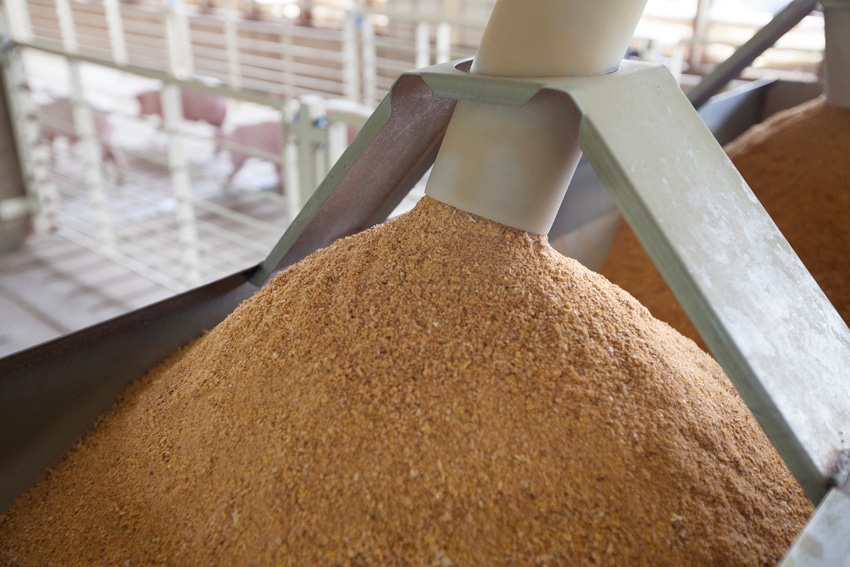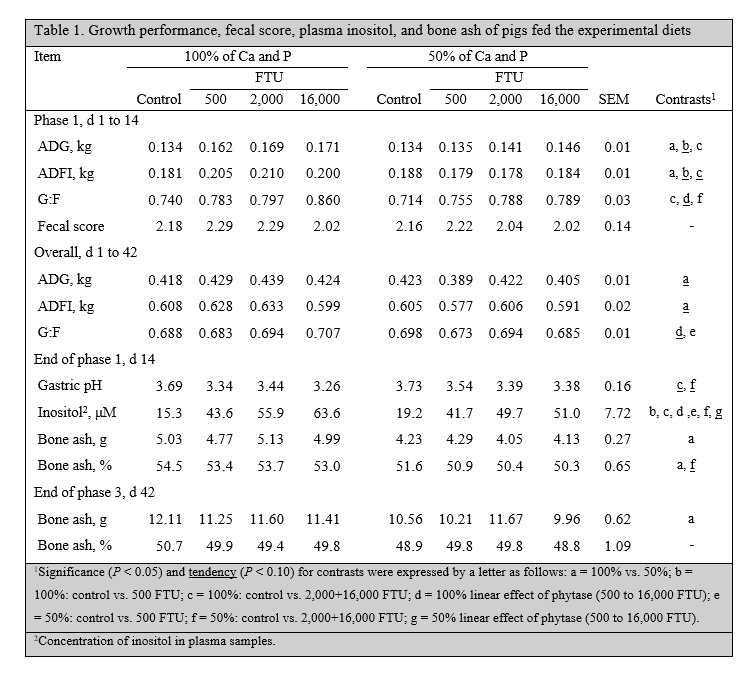Effects of reduced dietary Ca and P on weanling pigs
Inositol may be a conditionally essential nutrient during the immediate post-weaning period.
September 29, 2021

A low pH in the stomach of pigs is necessary for proper protein digestion, but it is believed that pigs may not be able to secrete sufficient HCl to maintain a low pH in the stomach during the initial post-weaning period. Insufficient acid secretion may result in reduced protein digestion, which is one of the causes of diarrhea and mortality during this period. Use of diets containing ingredients with high buffering capacity such as limestone and monocalcium phosphate may contribute to an increase in stomach pH, and therefore, lowering the concentration of these two ingredients in phase 1 diets may be beneficial for newly weaned pigs. Inclusion of phytase in diets may also provide beneficial effects to weanling pigs because phytase results in reduced need for Ca and P supplements, reduced anti-nutritional effects of phytate in diets and increased inositol release. An experiment was conducted to test the hypothesis that reducing the concentration of Ca and P in phase 1 diets results in reduced gastric pH and fecal score but that increasing inclusion levels of phytase overcomes the negative effects of low Ca and P on growth performance and bone ash.
Dietary treatments
Ten diets based on corn and soybean meal were formulated. For phase 1 (day 1 to 14), two control diets that contained either 100% or 50% of the requirement for total Ca and digestible P were formulated. Six diets in which 500, 2,000, or 16,000 phytase units per kg of feed (FTU) were added to each control diet were also formulated. In the six phytase-containing diets, provisions of total Ca and digestible P were reduced by 0.16% and 0.11%, respectively, to account for the expected release of Ca and P by phytase. For phases 2 (d 15 to 27) and 3 (d 28 to 42), common diets without phytase and with concentrations of Ca and P that met the requirement were used.
Growth performance
Results from phase 1 indicated that pigs fed diets formulated to contain 50% of the requirement for Ca and P had reduced ADG and ADFI compared with pigs fed diets that contained Ca and P at the requirement (Table 1). Within diets containing 100% of the required Ca and P, pigs fed diets with phytase above 500 FTU had greater ADG than pigs fed the control diet. However, regardless of dietary Ca and P, inclusion of high doses of phytase increased G:F of pigs. A tendency for a linear increase in G:F of pigs as phytase increased in diets with 100% Ca and P was also observed. From d 1 to 42, pigs fed phase 1 diets with 50% of the required Ca and P tended to have reduced ADG and ADFI compared with pigs fed phase 1 diets that contained 100% of the required Ca and P. Among pigs fed the 100% diets, there was a tendency for a linear increase in G:F as inclusion of dietary phytase increased.


Gastric pH, fecal score and bone ash
Feeding diets containing only 50% of the required Ca and P in phase 1 did not influence gastric pH or fecal score but resulted in reduced concentration of bone ash at d 14 and 42. Regardless of dietary Ca and P, phytase above 500 FTU tended to reduce gastric pH of pigs, but phytase supplementation did not affect fecal score or bone ash. The reason phytase did not affect bone ash is likely that provisions of Ca and P were reduced in diets containing phytase to take the expected release of Ca and P into account.
Plasma inositol
At the end of phase 1, regardless of dietary Ca and P, supplementation of phytase resulted in increased plasma inositol in pigs compared with pigs fed the control diets. Likewise, in pigs fed diets that contained Ca and P at the requirement, plasma inositol linearly increased when inclusion of phytase was increased. There was an interaction between diet and day for inositol in plasma (Fig. 1). Regardless of the quantity of Ca and P in phase 1 diets, concentrations of inositol in plasma on d 14 were greater in pigs fed diets with phytase compared with pigs fed the control diets, but on d 27 and d 42, plasma inositol was not influenced by dietary treatment. This observation indicates that during the first two weeks post-weaning, pigs are not able to synthesize sufficient quantities of inositol to maintain pre-weaning levels of plasma inositol, but inclusion of phytase enabled pigs to maintain inositol levels in plasma. On d 42, pigs appear to be capable of synthesizing sufficient inositol to bring plasma levels back to the pre-weaning value.

Conclusions
Lowering Ca and P in phase 1 diets does not influence gastric pH or fecal score but compromises growth performance and bone ash of pigs. However, regardless of dietary Ca and P, high doses of phytase increased inositol absorption and improved G:F of pigs. Inositol may be a conditionally essential nutrient during the immediate post-weaning period.
Sources: L. Vanessa Lagos and Hans Stein, University of Illinois, who is solely responsible for the information provided, and wholly own the information. Informa Business Media and all its subsidiaries are not responsible for any of the content contained in this information asset.
You May Also Like



